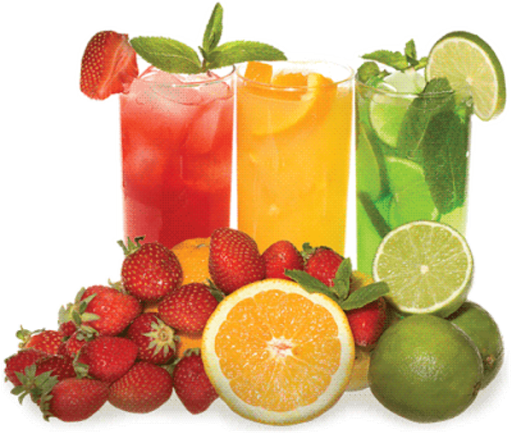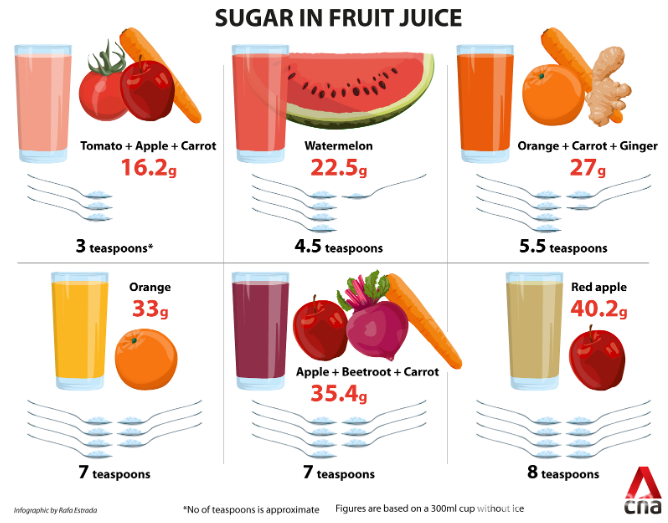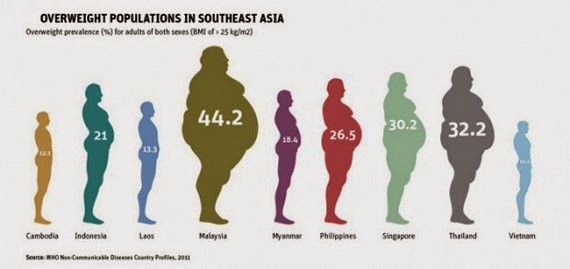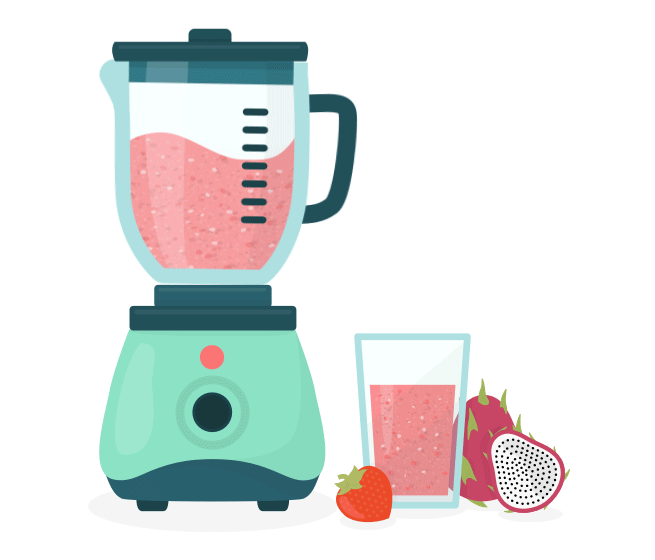Fruit juice: Is it really good for us?
To answer this, it really is a very tricky one. There are always two sides to a story when it comes to this. One believes that juicing is unhealthy than eating whole fruits due to the loss of fibre throughout the process, which makes fructose (sugar in fruit) absorb even quicker as compared to when it is combined with fibre, thus making it less healthy (1).
Another belief is that juicing is better than eating whole fruits and vegetables because the body can absorb them better and let the digestive tract rest from digesting fibre. If one considers blending fruit, that is even better since the edible fibre in it makes us feel full, so it promotes satiety (1).

So should we consider juicing, blending, or just eating raw fruits and vegetables?
Three longitudinal prospective cohort studies found that greater consumption of fruits such as blueberries, grapes, apples, bananas, and grapefruit reduced the risk of type 2 diabetes, while greater consumption of fruit juice was associated with an increased risk of type 2 diabetes (2).
When fruit is squeezed for its juice, what is left inside is basically sugar, vitamins, and antioxidants such as carotenoids, etc.; thus, it is healthier in this aspect as compared to frizzy drinks (3). However, the amount of sugar inside both of these drinks is about the same, which is about 20–26 g of sugar per cup (3).
The reason why fruit juice contains a higher sugar content as compared to fresh fruit even when it is 100% fruit juice without the addition of anything else is because, for example, in order to make 250 ml of orange juice, two medium-sized oranges are needed, and that is only 250 ml. Since when it is in liquid form, people tend to consume it even more, thus more fruits are needed. As the number of fruits increases, so does the sugar in them, but not the fibre inside, which in turn makes them have loads of sugar (1, 3, 4, 7, 8).

According to the Singapore Health Promotion Board, many people may think that naturally occurring sugar is healthier than added sugar, but actually there is no chemical difference between the two, and they have the same impact on blood sugar levels when ingested (8).
The same case goes to smoothies, not only because they have a lot of sugar from a large number of fruits, but also because various protein-based foods like yoghurt, milk, almond milk, etc. that are mixed together with them will increase their calories as well (4).
The high sugar levels in both of these drinks make them high-calorie beverages and thus pose the same effect as high-calorie food, which can lead to weight gain. As we know, Malaysia is the fattest country in Southeast Asia, and one of the contributing factors is a lack of knowledge on what can increase weight and what cannot.

Weight gain is linked to many health problems, such as heart diseases, metabolic syndrome, cancer, bone and joint problems, kidney problems, etc. (3).
A study on the composition of grapefruits with different methods of household processing also found out that the composition of antioxidants in blended grapefruit has a higher concentration of the beneficial compound as compared to juicing or hand squeezing (5).

However, as for the absorption of beta carotene, a study found that fruit and vegetable juice makes beta carotene absorb better as compared to blending or eating raw fruit. This is due to the fact that fibre hinders the absorption of beta-carotene (6).
The takeaway message
Eating raw fruit, juicing, and blending all have their pros and cons. What is important is to always take into account the amount of sugar and fibre content. All in all, make sure that you have a balanced, nutritious, and moderate diet as suggested by the Ministry of Health: eat 3 servings of vegetables per day and 2 servings of fruits per day. Vary the way vegetables and fruit are cooked or served and eat them in moderation.
References
-
Mayo Clinic. https://www.mayoclinic.org/healthy-lifestyle/nutrition-and-healthy-eating/expert-answers/juicing/faq-20058020
-
MurakiIsao, ImamuraFumiaki, Manson JoAnn E, Hu Frank B, Willett Walter C, van Dam Rob M et al. Fruit consumption and risk of type 2 diabetes: results from three prospective longitudinal cohort studies BMJ 2013; 347 :f5001. https://www.bmj.com/content/347/bmj.f5001
-
Healthline (n.d). Is Fruit Juice is as Unhealthy as Sugary Soda? https://www.healthline.com/nutrition/fruit-juice-vs-soda#sugar-content
-
Healthline (n.d). Juicing vs Blending: Which one is better for me? https://www.healthline.com/health/food-nutrition/juicing-vs-blending
-
Ram M Uckoo1, Guddadarangavvanahally K Jayaprakasha, V M Balasubramaniam, Bhimanagouda S Patil. Grapefruit (Citrus Paradisi Macfad) Phytochemicals Composition Is Modulated by Household Processing Techniques.
-
Julia K Kolodziejczyk1, Shirley W Flatt, Loki Natarajan, Ruth Patterson, John P Pierce, Gregory J Norman. Associations of Soluble Fiber, Whole Fruits/Vegetables, and Juice With Plasma Beta-carotene Concentrations in a Free-Living Population of Breast Cancer Survivors. Women Health 52(8). DOI: 10.1080/03630242.2012.728189
-
How many orange does it take to make a cup of orange juice? (n.d). https://www.eatdifferentrd.com/blog/2016/8/12/how-many-oranges-does-it-take-to-make-a-cup-of-oj
-
Chanel News Asia (CNA) International (2019). That cup of fresh fruit juice could contain as much sugar as a soft drink. https://www.channelnewsasia.com/news/singapore/fruit-juice-sugar-diabetes-health-risks-soft-drink-11708652




